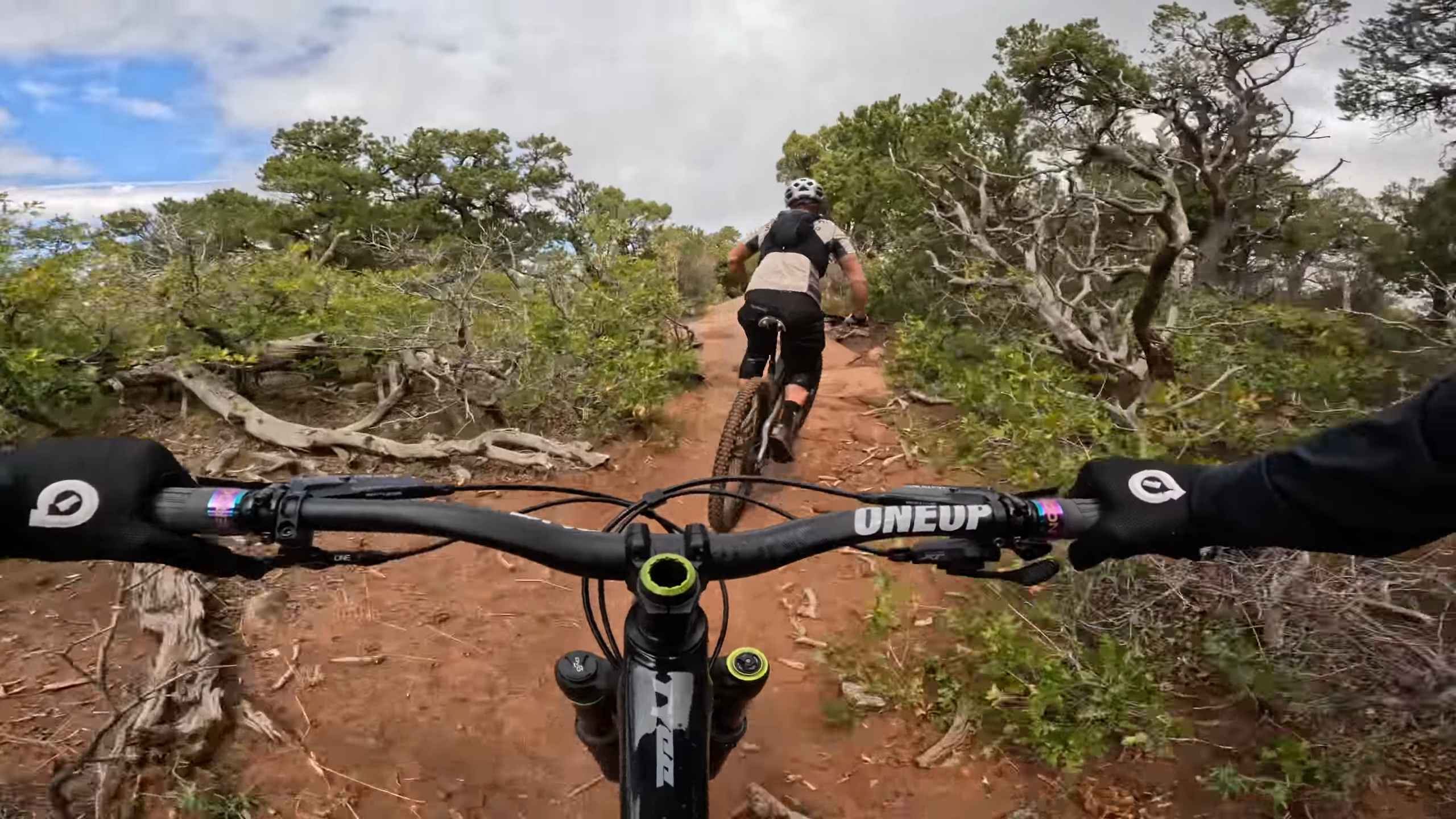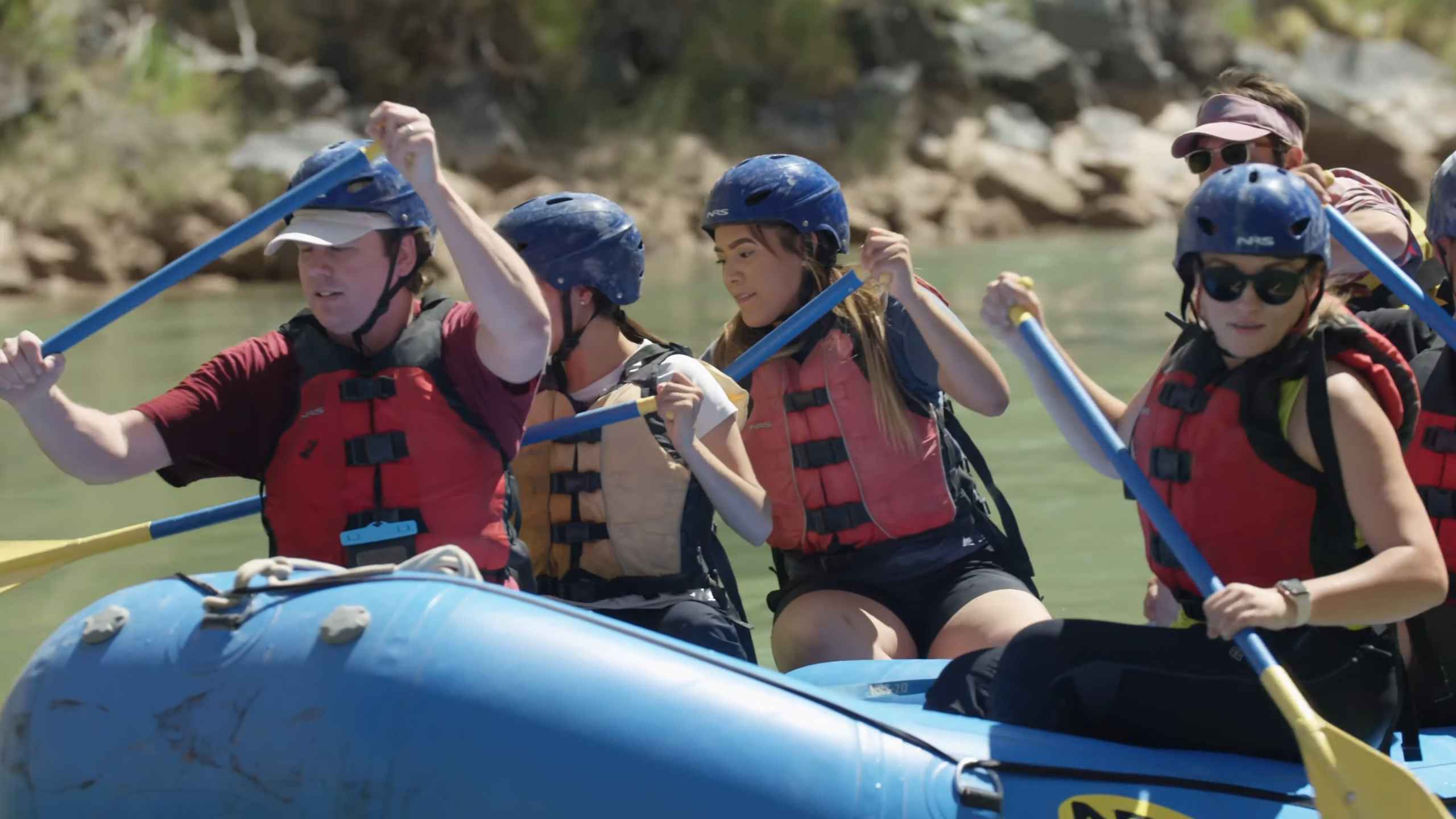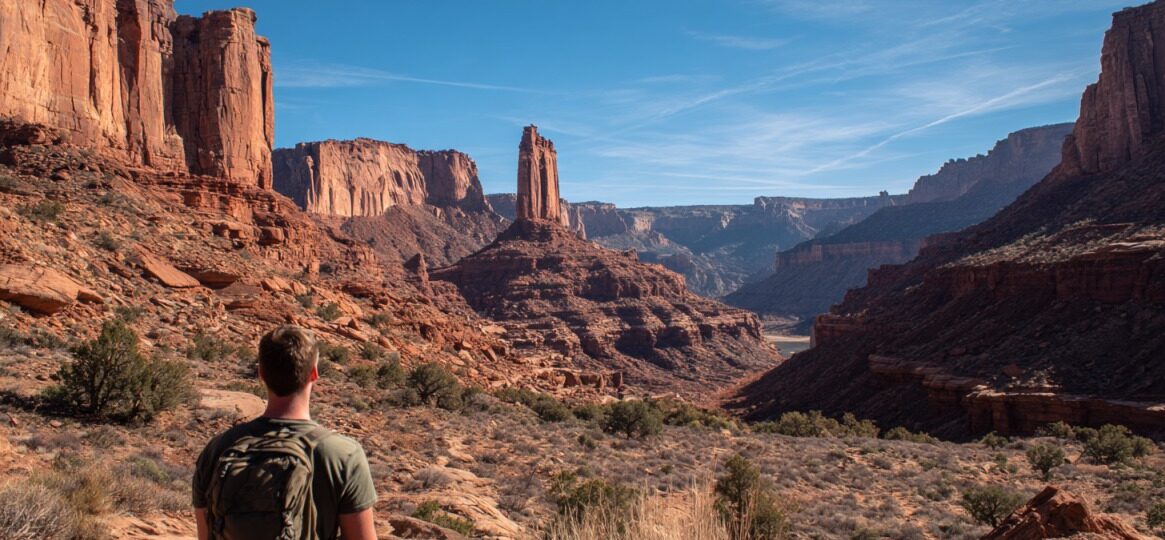Moab doesn’t waste your time. Set in Utah’s high desert with Mars-like rock formations and adrenaline-packed adventures, it delivers ten activities that actually live up to the hype.
No fluff. Just raw, memorable experiences worth your energy in 2025.
Let us see what Moab can offer.
10. Savor Moab’s Local Flavor
View this post on Instagram
After the hikes, climbs, paddles, and rides, Moab’s food scene feels like a reward you didn’t know you needed. Small-town doesn’t mean small effort here. Local chefs take bold swings, fusing global influence with high-desert comfort in ways that feel personal, unfussy, and totally satisfying.
Start with 98 Center, where Vietnamese fusion steals the show. Think pho with locally sourced vegetables, banh mi sandwiches loaded with depth, and cocktails that surprise with every sip. It’s not just good, it’s bold and memorable.
Morning crowds head to Más Café, a relaxed spot serving coffee worth waking up for and breakfast burritos that fuel an entire day of desert adventure. For something different, Birdy’s Finer Diner leans retro with modern edge, burgers, fries, and milkshakes, all upgraded without getting fancy.
Wrap up the day at Rooted Vine, a wine bar with small plates and smooth pours, perfect for unwinding.
- 98 Center: Vietnamese fusion with heart and serious flavor.
- Más Café: Breakfast and coffee staples done right.
- Birdy’s Finer Diner: Retro-inspired with elevated comfort food.
- Rooted Vine: Chill atmosphere with wine and bites that impress.
Prices sit in the mid-range sweet spot. Quality is high, and portions rarely leave you hungry. Staff tends to be friendly without the script, people who live in Moab for real, not just for the season.
9. Bring the Dinosaurs to Life at Moab Giants
Dinosaurs never really left Moab, they just got a lot more colorful, detailed, and larger than life. Moab Giants takes prehistoric fascination and cranks it up into a full-on outdoor and indoor experience that hits home for kids, adults, and anyone who ever watched Jurassic Park on repeat.
Set against a dramatic desert backdrop, the park features a life-size dinosaur trail where creatures once native to the area tower overhead. You’re not just looking at bones in a glass case, you’re walking beside them, craning your neck to see teeth, tails, and claws.
Inside, the 3D theater adds a little Hollywood to the fossil story, while interactive exhibits turn paleontology into something hands-on. Kids get to dig, touch, and roar along. Adults get pulled into timelines, footprints, and the science that brings ancient bones to life.
- Life-size dinosaur models: More than 100 along a desert walking path.
- 3D theater experience: Takes you into the world of dinosaurs in motion.
- Interactive museum: Touchscreens, fossil replicas, and guided learning stations.
- Paleontology dig pit for kids: Let them discover bones the way pros do.
The park sits just north of town, making it an easy detour between hikes or meals.
Cooler mornings are best, especially for the outdoor trails, bring hats, sunscreen, and extra water. And don’t rush. Every dino tells a story, and every exhibit rewards a second look.
8. Discover Moab’s Quirky Museums & Film History
在 Instagram 查看这篇帖子
Before Moab became a magnet for hikers and bikers, it was Hollywood’s desert backlot. Big skies, bare cliffs, and rugged terrain caught the eyes of directors chasing wide-open drama. Today, that legacy lives on inside Moab’s low-key but unforgettable museums.
The Moab Museum of Film and Western Heritage at Red Cliffs Lodge is the best place to start. Inside, visitors find vintage cameras, dusty cowboy hats, original posters, and behind-the-scenes stills that trace Moab’s screen presence.
Westerns ruled the past, but more recent flicks like Thelma & Louise, Indiana Jones and the Last Crusade, and HBO’s Westworld also shot scenes here.
What makes the museum click isn’t just the exhibits, it’s the stories. Film crews camped in the desert. Locals worked as extras. Horses outran cars in stunt scenes. It’s not a polished Hollywood homage. It’s Moab’s own memory book, and it’s proudly unfiltered.
- Film props and memorabilia: Cowboy gear, film reels, and scripts used in productions.
- Classic Western displays: Tribute to the genre that put Moab on the movie map.
- Modern movie exhibits: Artifacts from recent films and shows shot in the region.
- Historical photos of Moab during filming: See how the town transformed for the screen.
Admission is usually free, and it rarely feels crowded. That gives visitors time to wander slowly, read every caption, and soak in decades of cinematic dust and glory. Staff often share personal stories about the productions that passed through, adding extra texture to the displays.
7. Pedal Through Moab’s Mountain Biking Mecca

With more than 900 miles of trails, it caters to every type of rider. From beginners who just want a scenic cruise to seasoned shredders looking for the next technical drop, Moab delivers.
Slickrock Trail sits at the top of most riders’ lists. It’s world-famous for a reason: otherworldly rock textures, punchy climbs, fast rolls, and views that distract you just long enough to nearly send you off course. But that’s just one option.
Trails like Klonzo, Bar M, and Deadman’s Ridge offer gentler rides without watering down the experience.
Local outfitters make jumping into the sport easy. Rentals are tuned and trail-ready, guides know the terrain better than GPS, and shuttle services let you focus on the ride, not the logistics.
- 900+ miles of trails: A mix of slickrock, singletrack, packed dirt, and technical features.
- Options for all skill levels: Green trails for first-timers and black diamonds for adrenaline junkies.
- Epic views at every turn: Canyons, mesas, arches, and endless blue skies.
- Well-supported infrastructure: Gear rentals, guided tours, and shuttles all available.
Desert biking comes with its own rhythm. Start early to beat the heat and the crowds. Drink water constantly, even before you feel thirsty. And bring more snacks than you think you’ll eat. Trails are draining, and there’s no shame in stopping for a granola bar with a view.
6. Explore Canyoneering Adventures
View this post on Instagram
Canyoneering in Moab isn’t a walk through the desert, it’s a controlled plunge into tight sandstone canyons, ropes in hand, nerves buzzing. Grandstaff Canyon delivers one of the most unforgettable routes in the area, offering a full-body challenge that mixes hiking, scrambling, rappelling, and old-fashioned grit.
Morning Glory Arch is the crown jewel of this descent. At over 240 feet long, it’s one of the largest natural rock spans in the U.S. and you rappel right over the edge of it.
Stepping into that first drop, harness tugging tight and rope stretching into shadow, triggers a mix of excitement and adrenaline that no trail ever could.
Canyoneering guides make sure even beginners stay safe while tackling rugged terrain. Every move gets explained, every rope double-checked, and every scramble managed with quiet confidence. You’ll sweat, laugh, and probably shout “this is insane” more than once.
- Grandstaff Canyon descent: Offers one of the most thrilling routes in Moab.
- Rappel heights vary: Including the 100+ foot drop off Morning Glory Arch.
- Combination of hiking, scrambling, and ropework: Each section brings a new kind of physical puzzle.
- Scenery includes arches, pools, slot canyons, and vertical cliffs.
Don’t worry about bringing your own gear. Helmets, harnesses, gloves, and ropes are all provided by tour operators. Just show up in durable clothes that can get dusty and worn. Shoes with good grip are non-negotiable.
5. Watch the Sunset at Dead Horse Point
@ebstokes326 A beautiful sunset at Dead Horse Point State Park. #utah #visitutah #travel #adventure #foryou #forgoupage #hiking #hiketok #explore #deadhorsepoint #deadhorsepointstaepark ♬ Prodigal – Evoe
Canyons don’t get more cinematic than the ones unfolding at Dead Horse Point. Towering cliffs drop into labyrinths of carved rock, all lit by an ever-changing sky that looks painted by someone showing off.
As the sun drops, shadows stretch, colors sharpen, and everything slows down.
Phones come out, but most people eventually put them away, because the real show isn’t on a screen.
Perched 2,000 feet above the Colorado River, the overlook at Dead Horse Point delivers jaw-dropping views in every direction. It’s the kind of place where silence feels like part of the scenery. You don’t just see the desert, you feel it breathe.
Arrive early, find a rock ledge, and stay put. Watch light spill over cliff edges, then dip below the far horizon. After dark, stay for a different kind of drama: a sky filled with stars most city dwellers forgot existed.
- 360° views of desert cliffs and winding canyons: Photogenic in every direction.
- Designated dark sky site: Some of the clearest stargazing conditions in the U.S.
- Easy access by car: Short walk from parking to viewpoints.
- Restrooms and picnic tables available: Great for relaxed evenings and sunset snacks.
Nightfall here doesn’t mean “go home.” Stick around with a blanket and hot drink to catch planets, constellations, and maybe even a meteor or two. Park rangers occasionally host stargazing programs and laser-guided constellation tours, check the calendar before your visit.
4. Hike the Fisher Towers Trail
Fisher Towers looks like something dropped in from another planet. Vertical spires rise hundreds of feet in jagged shapes, with the most famous, The Titan, dominating the skyline like a twisted skyscraper made of rust. No visitor forgets the first time they stare up at it. The whole trail feels theatrical, like a backdrop designed for a fantasy film.
The hike itself is about 4.5 miles round trip, weaving through dry washes, along ledges, and beneath stone towers that change shape as the light shifts. Views open and close quickly, making each turn feel new. Despite the surreal setting, the trail doesn’t demand technical skills, just decent shoes and stamina.
Best time to hit it is late afternoon, when golden light hits the towers just right and shadows make the rock formations look even weirder. Mornings offer cooler temps and fewer people, but the drama really peaks just before sunset.
- The Titan and other rock giants: Some of the tallest freestanding spires in the U.S.
- Trail length: Around 4.5 miles round-trip, rated moderate.
- Photo opportunities at every turn: Great for wide shots, silhouettes, and close-up textures.
- Geological weirdness: Formations shaped by erosion, time, and imagination.
Trailheads have limited parking, so early arrival helps. Summer heat can turn sections into a sun-baked slog, so pack water and wear a wide-brimmed hat. But there are rock benches and outcroppings perfect for rest stops or quick snack breaks.
3. Zipline Over Desert Canyons
View this post on Instagram
Flying across open desert on a zipline doesn’t sound real until you’re strapped in, feet dangling, wind rushing your ears, and cliffs dropping hundreds of feet beneath you. Moab’s zipline course doesn’t copy what you’ll find in tree-filled resorts. It’s raw, suspended, and set against jagged red cliffs and empty blue sky.
Six ziplines launch riders between rocky platforms while a suspension bridge adds one more nerve-jangling highlight. Each ride lets you coast above desert spires and drop-offs, catching rare views you can’t get by hiking or biking. And unlike theme parks, there’s no crowd noise or concrete in sight. Just wind and rock.
Red stone underfoot, empty space all around, and a giant canyon echoing every laugh or scream. You’ll remember the view, but also the rush that hit your stomach right after the first launch.
- Six individual ziplines: Each with different lengths and speeds.
- Suspension bridge: High above the ground with just enough sway to keep your heart rate up.
- 360-degree desert views: Wide-open visibility with no obstructions.
- Safety instruction and gear included: Helmets, harnesses, and double-checked rigging.
Guides keep things safe and light-hearted. Nervous first-timers get encouragement and coaching. More confident riders can try poses or flips mid-flight, if they can handle it. Weight limits and age restrictions apply, so check ahead when booking.
2. Ride the Rapids of the Colorado River

The Colorado River slices through Moab with a mix of calm meanders and foaming whitewater, making it the perfect setting for both thrill-seekers and laid-back floaters. You don’t need to be a pro paddler to jump in. Local outfitters handle the gear, safety, and logistics. You just need to show up ready to get splashed.
Options stretch from gentle half-day floats to full-day adrenaline sessions that send rafts plunging through Class III rapids. All rides come with views straight out of a movie, towering red cliffs, hidden alcoves, and cottonwoods hugging the shoreline.
Wildlife keeps things interesting, too. Bald eagles soar overhead, and bighorn sheep often show up to pose on a cliff like they own the place.
Many tour operators turn river trips into all-day experiences. One minute you’re shooting rapids, the next you’re drying off on a sunny beach with a hot BBQ lunch and a cooler full of drinks. Not bad for a Tuesday in the desert.
- No experience needed: Guides handle navigation and safety, and explain every step.
- Family-friendly options: Calm floats are ideal for kids or those not chasing thrills.
- Whitewater sections deliver: Stronger rapids give you a shot of adrenaline without extreme risk.
- Scenery that constantly shifts: Every bend brings something new, rock walls, caves, wildlife.
Mornings tend to be calmer on the water, both in temperature and river conditions. Afternoons bring wind and sun exposure, so dress smart. Lightweight clothes, water shoes, sunglasses with retainers, and a hat make all the difference. Don’t forget sunscreen, desert sun bounces off water and doesn’t let up.
1. Marvel at Arches National Park’s Icons
View this post on Instagram
Delicate Arch, Landscape Arch, and The Windows Section offer a visual punch few natural sites can match. They aren’t just formations; they feel alive with texture, scale, and gravity-defying curves that make you question how they haven’t collapsed under their own weight.
No photo can capture the size or detail, they need to be seen in person.
Best light hits the arches during sunrise or sunset. Shadows stretch long, rock turns a glowing gold-orange, and the crowds thin out enough for real moments. Getting up before sunrise or staying past dinner is worth the payoff.
Planning a visit becomes easier after October when the park drops its timed-entry system. That opens up spontaneous road trips and flexible mornings without digital stress.
- Footwear matters: Trails range from flat sand to steep slickrock, and flip-flops won’t cut it.
- Hydration is crucial: Even short hikes feel longer under a relentless desert sun.
- Photography timing matters: Early morning gives cooler temperatures and better lighting for shots.
- Expect crowds: But they thin significantly in early morning and late evening, especially outside peak summer months.
Some people stop at Delicate Arch and call it good. But the Windows Section and Landscape Arch shouldn’t be skipped. One offers massive double arches you can walk beneath.
The other showcases the longest natural arch in North America. If the national park concept had a highlight reel, these three would dominate the intro.
Final Thoughts
Moab certainly impresses. Between red rock hikes, roaring rivers, prehistoric giants, and local bites that actually hit the mark, you walk away tired, dusty, and genuinely satisfied.
In a world full of tourist traps, Moab stays real. 2025 is the year to see why.

